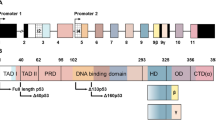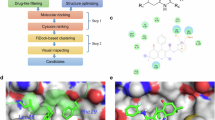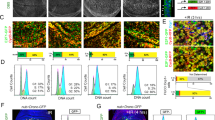Abstract
Cyclin-dependent kinase 1 (Cdk1)/cyclin B1 complex is the driving force for mitotic entry, and its activation is tightly regulated by the G2/M checkpoint. We originally reported that a novel protein C53 (also known as Cdk5rap3 and LZAP) potentiates DNA damage-induced cell death by modulating the G2/M checkpoint. More recently, Wang et al. (2007) found that C53/LZAP may function as a tumor suppressor by way of inhibiting NF-κB signaling. We report here the identification of C53 protein as a novel regulator of Cdk1 activation. We found that knockdown of C53 protein causes delayed Cdk1 activation and mitotic entry. During DNA damage response, activation of checkpoint kinase 1 and 2 (Chk1 and Chk2) is partially inhibited by C53 overexpression. Intriguingly, we found that C53 interacts with Chk1 and antagonizes its function. Moreover, a portion of C53 protein is localized at the centrosome, and centrosome-targeting C53 potently promotes local Cdk1 activation. Taken together, our results strongly suggest that C53 is a novel negative regulator of checkpoint response. By counteracting Chk1, C53 promotes Cdk1 activation and mitotic entry in both unperturbed cell-cycle progression and DNA damage response.
Similar content being viewed by others
Log in or create a free account to read this content
Gain free access to this article, as well as selected content from this journal and more on nature.com
or
References
Sancar A, Lindsey-Boltz LA, Unsal-Kacmaz K, Linn S . Molecular mechanisms of mammalian DNA repair and the DNA damage checkpoints. Annu Rev Biochem 2004; 73:39–85.
Cimprich KA, Shin TB, Keith CT, Schreiber SL . cDNA cloning and gene mapping of a candidate human cell cycle checkpoint protein. Proc Natl Acad Sci USA 1996; 93:2850–2855.
Shiloh Y . Ataxia-telangiectasia and the Nijmegen breakage syndrome: related disorders but genes apart. Annu Rev Genet 1997; 31:635–662.
Furnari B, Rhind N, Russell P . Cdc25 mitotic inducer targeted by Chk1 DNA damage checkpoint kinase. Science 1997; 277:1495–1497.
Matsuoka S, Huang M, Elledge SJ . Linkage of ATM to cell cycle regulation by the Chk2 protein kinase. Science 1998; 282:1893–1897.
Liu Q, Guntuku S, Cui XS, et al. Chk1 is an essential kinase that is regulated by Atr and required for the G(2)/M DNA damage checkpoint. Genes Dev 2000; 14:1448–1459.
Shieh SY, Ahn J, Tamai K, Taya Y, Prives C . The human homologs of checkpoint kinases Chk1 and Cds1 (Chk2) phosphorylate p53 at multiple DNA damage-inducible sites. Genes Dev 2000; 14:289–300.
Takai H, Tominaga K, Motoyama N, et al. Aberrant cell cycle checkpoint function and early embryonic death in Chk1(−/−) mice. Genes Dev 2000; 14:1439–1447.
Brown EJ, Baltimore D . ATR disruption leads to chromosomal fragmentation and early embryonic lethality. Genes Dev 2000; 14:397–402.
Syljuasen RG, Sorensen CS, Hansen LT, et al. Inhibition of human Chk1 causes increased initiation of DNA replication, phosphorylation of ATR targets, and DNA breakage. Mol Cell Biol 2005; 25:3553–3562.
Kramer A, Lukas J, Bartek J . Checking out the centrosome. Cell Cycle 2004; 3:1390–1393.
Doxsey S, McCollum D, Theurkauf W . Centrosomes in cellular regulation. Annu Rev Cell Dev Biol 2005; 21:411–434.
Doxsey S, Zimmerman W, Mikule K . Centrosome control of the cell cycle. Trends Cell Biol 2005; 15:303–311.
Jackman M, Lindon C, Nigg EA, Pines J . Active cyclin B1-Cdk1 first appears on centrosomes in prophase. Nat Cell Biol 2003; 5:143–148.
Hirota T, Kunitoku N, Sasayama T, et al. Aurora-A and an interacting activator, the LIM protein Ajuba, are required for mitotic commitment in human cells. Cell 2003; 114:585–598.
Dutertre S, Cazales M, Quaranta M, et al. Phosphorylation of CDC25B by aurora-A at the centrosome contributes to the G2-M transition. J Cell Sci 2004; 117:2523–2531.
Kramer A, Mailand N, Lukas C, et al. Centrosome-associated Chk1 prevents premature activation of cyclin-B-Cdk1 kinase. Nat Cell Biol 2004; 6:884–891.
Tsvetkov L, Xu X, Li J, Stern DF . Polo-like kinase 1 and Chk2 interact and co-localize to centrosomes and the midbody. J Biol Chem 2003; 278:8468–8475.
Ching YP, Qi Z, Wang JH . Cloning of three novel neuronal Cdk5 activator binding proteins. Gene 2000; 242:285–294.
Wang J, He X, Luo Y, Yarbrough WG . A novel ARF-binding protein (LZAP) alters ARF regulation of HDM2. Biochem J 2006; 393:489–501.
Jiang H, Luo S, Li H . Cdk5 activator-binding protein C53 regulates apoptosis induced by genotoxic stress via modulating the G2/M DNA damage checkpoint. J Biol Chem 2005; 280:20651–20659.
Ward IM, Chen J . Histone H2AX is phosphorylated in an ATR-dependent manner in response to replicational stress. J Biol Chem 2001; 276:47759–47762.
Ng CP, Lee HC, Ho CW, et al. Differential mode of regulation of the checkpoint kinases CHK1 and CHK2 by their regulatory domains. J Biol Chem 2004; 279:8808–8819.
Shiromizu T, Goto H, Tomono Y, et al. Regulation of mitotic function of Chk1 through phosphorylation at novel sites by cyclin-dependent kinase 1 (Cdk1). Genes Cells 2006; 11:477–485.
Yin X, Warner DR, Roberts EA, Pisano MM, Greene RM . Novel interaction between nuclear co-activator CBP and the CDK5 activator binding protein - C53. Int J Mol Med 2005; 16:251–256.
Bartek J, Lukas J . Chk1 and Chk2 kinases in checkpoint control and cancer. Cancer Cell 2003; 3:421–429.
Guo Z, Kumagai A, Wang SX, Dunphy WG . Requirement for Atr in phosphorylation of Chk1 and cell cycle regulation in response to DNA replication blocks and UV-damaged DNA in Xenopus egg extracts. Genes Dev 2000; 14:2745–2756.
Niida H, Tsuge S, Katsuno Y, Konishi A, Takeda N, Nakanishi M . Depletion of Chk1 leads to premature activation of Cdc2-cyclin B and mitotic catastrophe. J Biol Chem 2005; 280:39246–39252.
Lu X, Nannenga B, Donehower LA . PPM1D dephosphorylates Chk1 and p53 and abrogates cell cycle checkpoints. Genes Dev 2005; 19:1162–1174.
Fujimoto H, Onishi N, Kato N, et al. Regulation of the antioncogenic Chk2 kinase by the oncogenic Wip1 phosphatase. Cell Death Differ 2006; 13:1170–1180.
Oliva-Trastoy M, Berthonaud V, Chevalier A, et al. The Wip1 phosphatase (PPM1D) antagonizes activation of the Chk2 tumour suppressor kinase. Oncogene 2007; 26:1449–1458.
Dozier C, Bonyadi M, Baricault L, Tonasso L, Darbon JM . Regulation of Chk2 phosphorylation by interaction with protein phosphatase 2A via its B' regulatory subunit. Biol Cell 2004; 96:509–517.
Nojima H . G1 and S-phase checkpoints, chromosome instability, and cancer. Methods Mol Biol 2004; 280:3–49.
Wang J, An H, Mayo MW, Baldwin AS, Yarbrough WG . LZAP, a putative tumor suppressor, selectively inhibits NF-kappaB. Cancer Cell 2007; 12:239–251.
Zhou BB, SJ Elledge . The DNA damage response: putting checkpoints in perspective. Nature 2000; 408:433–439.
Zhou BB, Bartek J . Targeting the checkpoint kinases: chemosensitization versus chemoprotection. Nat Rev Cancer 2004; 4:216–225.
Li H, Bergeron L, Cryns V, et al. Activation of caspase-2 in apoptosis. J Biol Chem 1997; 272:21010–21017.
Acknowledgements
We thank Dr J Bartek (Danish Cancer Society) for Chk1-GFP-PACT construct. We are grateful for the insightful advice from Drs Junying Yuan (Harvard Medical School), Qingshen Gao, Jacek Topczewski, Kathy Randell, Bernard Mirkin (Northwestern University) and Marcus Peter (University of Chicago), and the help from Drs Francis Szele and Ed Kang (Children's Memorial Research Center and Northwestern University) on time-lapse videomicroscopy and William Goossens (Children's Memorial Research Center) on confocal microscopy. The project was supported by NIH grant R21 AG027840 and R01 GM081776 (to H Li), Children's Memorial Research Center and the Clarke family.
Author information
Authors and Affiliations
Corresponding author
Supplementary information
Supplementary information, Figure S1
C53 overexpression abrogated the G2/M arrest induced by etoposide. (PDF 168 kb)
Supplementary information, Figure S2
In vitro interaction between C53 and Chk1. (PDF 321 kb)
Supplementary information, Figure S3
Overexpression of C53 and its fragments alone in HeLa cells does not affect Cdk1 activation. (PDF 103 kb)
Supplementary information, Figure S4
Co-localization of C53 and Chk1 at the centrosome. (PDF 599 kb)
Supplementary information, Figure S5
Inactive Cdk1 (p-Y15-Cdk1) decorated centrosomes in C53-depleted U-2 OS cells. (PDF 485 kb)
Supplementary information, Figure S6
C53-GFP-PACT fusion protein targeted the centrosome. (PDF 664 kb)
Rights and permissions
About this article
Cite this article
Jiang, H., Wu, J., He, C. et al. Tumor suppressor protein C53 antagonizes checkpoint kinases to promote cyclin-dependent kinase 1 activation. Cell Res 19, 458–468 (2009). https://doi.org/10.1038/cr.2009.14
Received:
Revised:
Accepted:
Published:
Issue date:
DOI: https://doi.org/10.1038/cr.2009.14
Keywords
This article is cited by
-
Cdk5rap3 is essential for intestinal Paneth cell development and maintenance
Cell Death & Disease (2021)
-
CDK5RAP3 as tumour suppressor negatively regulates self-renewal and invasion and is regulated by ERK1/2 signalling in human gastric cancer
British Journal of Cancer (2020)
-
CDK5RAP3 inhibits angiogenesis in gastric neuroendocrine carcinoma by modulating AKT/HIF-1α/VEGFA signaling
Cancer Cell International (2019)
-
Loss of LZAP inactivates p53 and regulates sensitivity of cells to DNA damage in a p53-dependent manner
Oncogenesis (2017)
-
The putative tumor suppressor C53 interacts with the human telomerase reverse transcriptase hTERT and regulates telomerase activity
Chinese Science Bulletin (2014)



